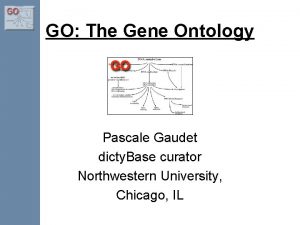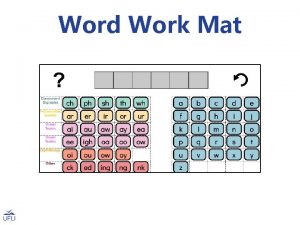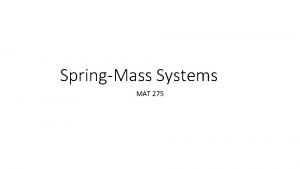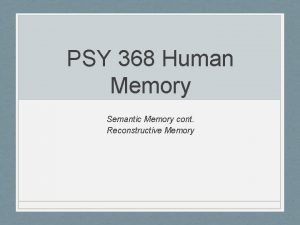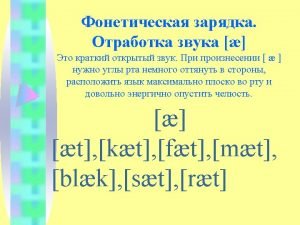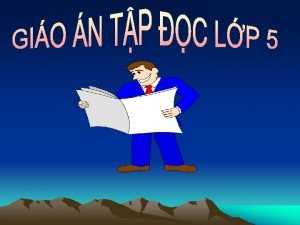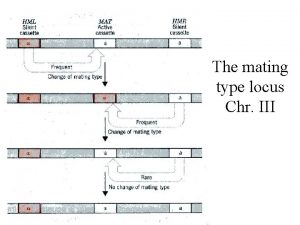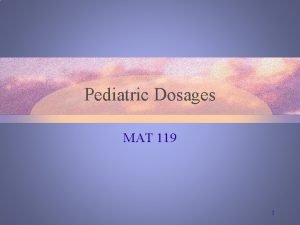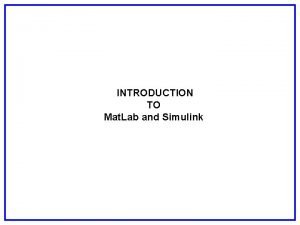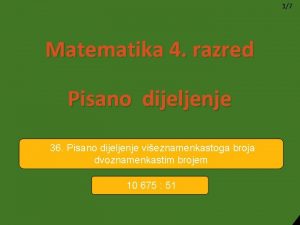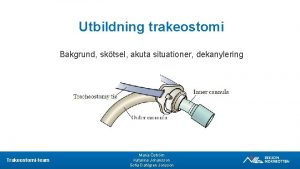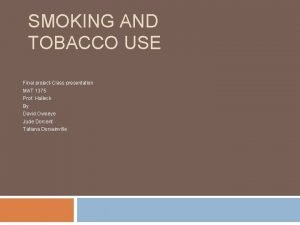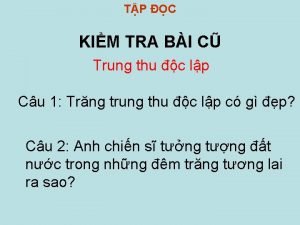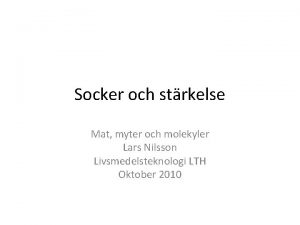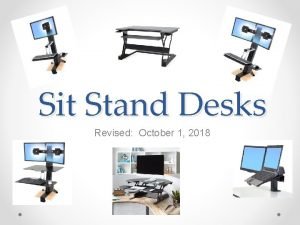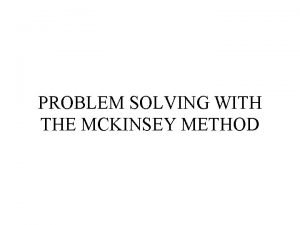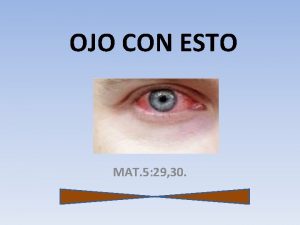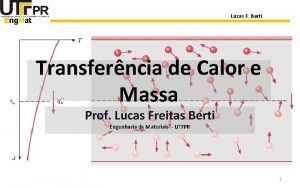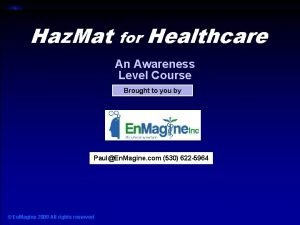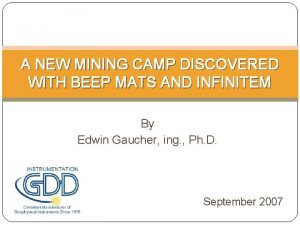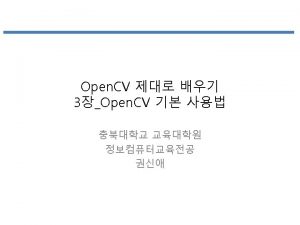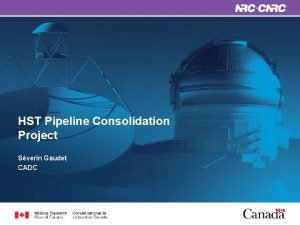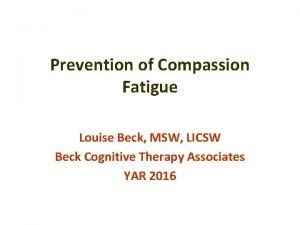MAT comes to DOC Mike Gaudet LICSW New


















































































































- Slides: 114

MAT comes to DOC Mike Gaudet, LICSW New England ATTC Consultant and Trainer

Disclosures The development of these training materials were supported by grant H 79 TI 080209 (PI: S. Becker) from the Center for Substance Abuse Treatment, Substance Abuse and Mental Health Services Administration, United States Department of Health and Human Services. The views and opinions contained within this document do not necessarily reflect those of the US Department of Health and Human Services, and should not be construed as such.

Goals of Today’s Training After this training, you will be more familiar with: ü Statistics regarding Substance Use Disorders (SUDO) and Incarcerations ü OUD’s effects on the brain ü Medications: what they are, how they work ü Benefits of MAT in CJ systems ü Self-care Strategies

What do you need today? ● Break into small groups ● Take 15 minutes to come up with ONE goal that you would like addressed today ● Choose one from among each group to share that goal with the rest of the class.

What are the Typical Questions and concerns? ● ● The Medications: ○ Methadone, Buprenorphine, Vivitrol ○ Diversion, safety concerns The DOC Staff: ○ How long do people stay on these medications? ○ How is it not prolonging the addiction process?

What are your specific questions and concerns? ● How to make sure there are systems available for door-to-door referral ● How to coordinate treatment prior to discharge ● Unclear goals within the DOC systems ● Internal steps to decrease/eliminate diversion ● How is dose determined ● How do you deal with persons who give evidence of multiple substance use

What are your specific questions and concerns? ● Why are people on MAT for a long time? ● Why are people placed on MAT prior to d/c when they’ve been sober while incarcerated? ● Why prescribe a replacement drug? ● What should we expect of the offender? ● What can we do to avoid burn-out?

Number of incarcerated persons by reason for confinement 1 1. Source: www. prisonpolicy. org/reports/pie 2018

Number of incarcerated persons by reason for confinement

Minimum Prison sentences Per Substance

Some sobering statistics… What does this all mean for the Criminal Justice System? Ø 1 in 3 of the 2 million persons with OUD in the US are arrested Ø Nearly 1 in 10 persons will die within 2 years after an initial overdose Ø There is a 50% reduction in number of deaths for those on MAT Ø Only about 5% of persons with OUD are getting MAT Ø Opioid death rates are 120 x’s greater in MA for those with a history of incarceration. In VT? Ø Majority of life-threatening incidents occurs within 4 weeks of release. Ø Overdose deaths are 30 times higher for homeless population Ø There are higher rates of overdose for those with co-occurring disorders Ø Sixty-five percent of all incarcerated individuals meet the criteria for a substance use disorder. Ø Use of opioids—which include prescription pain relievers, heroin, and synthetic opioids such as fentanyl—is linked with a higher rate of recidivism.

Even More Sobering Facts Inmates in the U. S. Do Not Receive Adequate Treatment for Addiction Only 11 percent of inmates who need substance use disorder treatment in the U. S. receive any form of it. The World Health Organization recommends that all prisons make methadone and buprenorphine available for treatment and naltrexone available for relapse prevention. Medications remain underutilized: As of 2009, while 55 percent of U. S. prison systems offered methadone treatment, more than 50 percent did so only for pregnant women; only 14 percent offered buprenorphine treatment for any inmates. Medications are underused by drug courts. However, as of 2015, state drug courts receiving federal grants must allow people being treated with medications for opioid addiction to continue their use. 2. Source; Treating Opioid Addiction in the Criminal Justice System 2

Four Reasons to Not Bring MAT to DOC ● ● In an article entitled ‘Treatment May not Help Inmates’ (January 4, 2019), author Andrew Klein of Advocates for Human Potential suggests that medication for inmates may not be the right course of action. According to Klein, “The real issue is should jails and prisons provide opioid medications for those already on these medications or for those who request them to prevent relapse upon release? The answer is not clear cut one way or the other. ” Mr. Klein states that the motivation to begin agonist medication is primarily to avoid the agony of withdrawal, not for sustained recovery. He contends that once released from prison, the person soon returns to illicit use.

Four Reasons to Not Bring MAT to DOC The Four Reasons Rationale 1. Offering medications in jails/prisons when they are not readily available upon release. Prescribers and programs are scarce or non-existent in many communities. Costs too much. 2. Continue them on medication if they are not able or willing to stick to the rules. Many individuals entering with prescriptions for Methadone or Buprenorphine are mixing meds with additional narcotics, benzos and alcohol. Reason-busters

Four Reasons to Not Bring MAT to DOC The Four Reasons 3. Polysubstance-abusing persons may not be able to sustain a regimen for daily medication. Rationale Diversion of Buprenorphine in the community is the rule, not the exception. 11000 children and adolescents reported to poison control centers for exposure between 2007 and 2016. 4. Why medicate when most CT study: 40. 6% returned to do not continue once released illicit use after release within from the system? the first 30 days. RI DOC reports that 32% induced on methadone/Buprenorphine continued on medication after release. Reason-busters

Four Reasons to Not Bring MAT to DOC YOUR CHALLENGE TODAY IS TO FIND THE REASON-BUSTERS TO THE FOUR REASONS IDENTIFIED BY KLEIN ●

Why Initiate and Maintain MAT in Jails and Prisons and refer to community providers upon discharge More than half of inmates will relapse within one month of release. Reasons Include, but are not limited to: Peer Pressure Isolation Familial Pressure Disillusionment and Apathy Tensions in Daily Life The Stress of Complying with DOC Few Job Opportunities Lack of Safe Housing Inadequate Follow-up Treatment Other? 3 3. Source: Medication Assisted Treatment in the Criminal Justice System. Power. Point Presentation. ATTC, May 2015.

Why Initiate and Maintain MAT in Jails and Prisons and refer to community providers upon discharge ● Death rates surge 200% to 700% in the first few weeks after correctional institution release primarily due to opioid overdose. ● In RI, post-release deaths decreased by 60. 5%, and overall statewide overdose deaths dropped by 12. 5% after one year of MAT. ● Relapse and overdose rates justify referral to MAT post-release. 4 4. Source: Medication Assisted Treatment in the Criminal Justice System. Power. Point Presentation. ATTC, May 2015.

Why Initiate and Maintain MAT in Jails and Prisons and refer to community providers upon discharge Providing medication improves post-release outcomes ● ● Inmates treated with methadone or buprenorphine prior to release are more likely to engage in post-release treatment, and to stay in treatment longer. A recent NIDA-funded study found treatment with extended-release naltrexone reduced relapse rates among criminal justice-involved adults with a history of opioid dependence. Forced discontinuation of methadone treatment during incarceration can lead to a reluctance to engage in future treatment, due to the severe and extended withdrawal symptoms that occur when these medications are abruptly discontinued. Opioid dependent patients allowed to continue methadone treatment during incarceration are less likely to be re-arrested than those who are detoxified in jail. Over 97 percent of those receiving methadone continued treatment after release. 5 5. Source: Implementing Opioid Agonist Treatment in Correctional Facilities, 2018.

Benefits to the CJ System Include: Public safety Rate of opiate overdose Public health Recidivism Effectiveness of Probation & Parole Public and DOC costs 6 6. Source: Medication Assisted Treatment in the Criminal Justice System. Power. Point Presentation. ATTC, May 2015.

Increased Public Health Drug abuse treatment is HIV and HCV prevention! • Drug injectors who do not enter treatment are up to 6 x more likely to become infected with HIV than injectors who enter and remain in treatment • Treatment reduces associated risk behaviors such as sharing injection equipment and unprotected sex • Treatment provides opportunities for screening, counseling, and referral to additional services, including early HIV treatment

Decreasing Criminal Behaviors Crime Days Per Year 300 250 200 Before TX During TX 150 100 50 7 0 A B C D E F 7. Source: Medication Assisted Treatment in the Criminal Justice System. Power. Point Presentation. ATTC, May 2015.

Mean Crime-Days per yr. Longer Time in MAT Decreases Crime-Days

Relapse Rates 100 82. 1 Percent IV Users 80 72. 2 60 57. 6 45. 5 40 28. 9 20 0 IN 1 to 3 4 to 6 7 to 9 10 to 12 8 Treatment Months Since Stopping Treatment 8. Source: Medication Assisted Treatment in the Criminal Justice System. Power. Point Presentation. ATTC, May 2015.

Effect of MAT on Parole & Probation An additional tool for repeat offenders ● Increased retention and effectiveness of community SUDO treatment ● Decreased recurrent drug use ● Decreased behavioral problems and crime ● Decreased violations and arrests ● Decreased P&P workload & hassles

Effect of MAT on DOC Budget ● Reduces the number of persons going through repeated arrest-incarceration-release cycle. ● Increases retention and effectiveness of community SUDO treatment ● Decreases recurrent drug use ● Decreases drug-related crime ● Decreases violating or arresting Persons with SUDO ● Increases community time between relapses ● Decreases incarceration costs

What Influences a CO’s or PO’s Attitude about MAT? Favorable Attitude Unfavorable Attitude Knowledge about MAT Little knowledge about MAT Understands role to be one of assisting reintegration Less therapeutic or supportive role Understands centrality of SUTx in achieving goals Understands MAT as substituting one drug for another In favor of anything that makes job easier Believes that MAT was not strict enough Positive personal beliefs about MAT Limited understanding about addiction and recovery Understands the importance of personal choice Believes that people should eventually get off meds Has a favorable attitude toward OTP’s Has the impression that OTP’s were ‘dose and goes’ Understands that MAT was evidence-based Understands MAT as no more than a ‘last resort’ Feels compassion for the inmate Feels responsible for the inmate Understands the role of the courts/judge Has no choice but to comply with courts/judge Positive and supportive philosophical environment The environment has ‘zero tolerance’ for all drugs Other? Taken from: Mitchell, Shannon Gwin. Et. Al. (2016) Community Correctional Agents’ Views of Medication-Assisted Treatment: Examining their Influence on Treatment Referrals and Community Supervision Practices. Substance Abuse.

Basic Information about Opioid Use Disorder (OUD) Research shows… that prolonged drug use can change brain chemistry. A. Adaptation of receptor sites B. Brain regions involving executive function weaken C. Conversion of receptor sites D. Desensitization of reward system

Basic Opioid Facts ● When Opiate Receptors are activated, they reduce the perception of pain and produce a sense of well-being. ● They can also cause drowsiness, mental confusion, nausea and constipation. ● With repeated illicit use, the production of endogenous opioids is inhibited and atrophies. ● With repeated use, tolerance sets in which results in need for more of the drug to achieve the desire effect. Some deaths due to lapse/relapse are related to tolerance; the user’s tolerance decreased during recovery.

Opium ( www. streetdrugs. org)

Morphine (www. streetdrugs. org)

Opioid Agonists ● Semisynthetics: Derived from chemicals in opium ○ Diacetylmorphine – Heroin ■ Hydromorphone – Dilaudid® ■ Oxycodone – Percodan®, Percocet® ■ Hydrocodone – Vicodin®

Heroin (www. streetdrugs. org)


Opioid Agonists (www. pdrhealth. com)

Opioid Agonists ● Synthetics ○ Propoxyphene – Darvon®, Darvocet® ○ Meperidine – Demerol® ○ Fentanyl citrate – Fentanyl® ○ Methadone – Dolophine® ○ Levo-alpha-acetylmethadol – ORLAAM®

Opioid Agonists ● Synthetics ○ Propoxyphene – Darvon®, Darvocet® ○ Meperidine – Demerol® ○ Fentanyl citrate – Fentanyl® ○ Methadone – Dolophine® ○ Levo-alpha-acetylmethadol – ORLAAM®

Methadone Fentanyl Darvocet (www. methadoneaddiction. net/m-pictures. htm)

What is Fentanyl? ● ● Pharmaceutical fentanyl is a synthetic opioid pain reliever, approved for treating severe pain, typically advanced cancer pain. It is 50 to 100 times more potent than morphine. It is prescribed in the form of transdermal patches or lozenges and can be diverted for misuse and abuse in the United States. Most recent cases of fentanyl-related harm, overdose, and death in the U. S. are linked to illegally made fentanyl. It is sold through illegal drug markets for its heroinlike effect. It is often mixed with heroin and/or cocaine as a combination product —with or without the user’s knowledge— to increase its euphoric effects.

Opioid Partial Agonists ● Buprenorphine – Buprenex®, Suboxone®, Subutex® ● Pentazocine – Talwin®

Buprenorphine/Naloxone Combination and Buprenorphine Alone

Opioid Antagonists ● Naloxone – Narcan® ● Naltrexone – Re. Via®, Trexan® ● Vivitrol

Possible Acute Effects of Opioid Use ● Surge of pleasurable sensation = “rush” ● Warm flushing of skin ● Dry mouth ● Heavy feeling in extremities ● Drowsiness ● Clouding of mental function ● Slowing of heart rate and breathing ● Nausea, vomiting, and severe itching

Consequences of Opioid Use (Not an exhaustive list) ● Addiction ● Overdose ● Death ● Use related (Hep B, C, D, HIV infection, malnutrition) ● Negative consequences from injection: ○ Infectious diseases (e. g. , HIV/AIDS, Hepatitis B and C) ○ Collapsed veins ○ Infection of heart lining and valves ○ Arthritis and other rheumatologic problems ○ Bacterial infections ○ Abscesses

Short Term Effects Long Term Effects

Abscesses from IV Use

Heroin Withdrawal Syndrome ● Intensity varies with level & chronicity of use ● Cessation of opioids causes a rebound in function altered by chronic use ● First signs occur shortly before next scheduled dose ● Duration of withdrawal is dependent upon the half-life of the drug used: ○ Peak of withdrawal occurs 36 to 72 hours after last dose ○ Acute symptoms subside over 3 to 7 days ○ Protracted symptoms may linger for weeks or months

Opioid Withdrawal Syndrome Acute Symptoms ● Pupillary dilation ● Lacrimation (watery eyes) ● Rhinorrhea (runny nose) ● Muscle spasms (“kicking”) ● Yawning, sweating, chills, gooseflesh ● Stomach cramps, diarrhea, vomiting ● Restlessness, anxiety, irritability

Opioid Withdrawal Syndrome Protracted Symptoms ● Deep muscle aches and pains ● Insomnia, disturbed sleep ● Poor appetite ● Reduced libido, impotence, anorgasmia ● Depressed mood, anhedonia ● Drug craving and obsession

Physical Signs of W/D and Time to Onset Stage Grade Physical Signs and Symptoms Early Withdrawal: Short-acting opioids: 824 hours after last use. Long-acting opioids: up to 36 hours after last use. 1 Lacrimation, rhinorrhea or both, Diaphoresis, yawning, restlessness, insomnia. Early Withdrawal: (see above) 2 Dilated pupils, Piloerection, Muscle twitching, Mylagia, Arthralgia, Abdominal pain Fully-developed Withdrawal: Short-acting opioids: 1 -3 days after last use. Longacting opioids: 72 -96 hours after last use. 3 Tachycardia, Hypertension, Tachypnea, Fever, Anorexia or nausea, Extreme restlessness. Fully-developed Withdrawal: (see above) 4 Diarrhea, vomiting or both, Dehydration, Hyperglycemia, Hypotension, Curled-up position. Total duration of withdrawal: Short-acting opioids: 7 -10 days Long-acting opioids: 14 days or more. 9. Source: TIP 63 9.

How do medications for OUD work? ● Agonists ○ ● Partial Agonists ○ ● Produce opioid effects Produce moderate opioid effects Antagonists ○ Block opioid effects

Agonist Therapy: Methadone (www. methadoneaddiction. net/m-pictures. htm)

Agonist Therapy: Methadone Overmedication signs: pinpoint pupils, drowsy, nodding off, listless mental status, itching/scratching, flushing, decreased body temperature, slowed heartbeat, feeling high. Peak Normal Range “Comfort Zone” Subjective w/d: Drug-craving, anxious feelings or depression, irritability, Trough fatigue insomnia, hot/cold flashes, aching muscles/joints, nausea, disorientation, restlessness. Objective w/d: dilated pupils, illicit opioid use, goose flesh, perspiring, shaking, diarrhea, vomiting, runny nose, sneezing, yawning, fever, hypertension, increased heartbeat and/or respirations. 0 hrs time 10. Source: TIP 63 24 hrs 10

Agonist Therapy: Methadone ● Dose Determination: ü History of use ü History of last agonist treatment ü Induction Period ü Achievement of a steady state ü Peak and trough

Partial-Agonist Therapy: Buprenorphine ● Buprenorphine is currently marketed for opioid treatment under the trade names: Suboxone® (buprenorphine/naloxone) Subutex® (buprenorphine) ● ● ● Over 25 years of research Over 5, 000 patients exposed during clinical trials Proven safe and effective for the treatment of opioid addiction Zubsolv

Partial-Agonist Therapy: Buprenorphine ● ● Probuphine: Implant designed for persons who are stable for 6 or more months. It is indicated for the maintenance treatment of opioid dependence in patients who have achieved and sustained prolonged clinical stability on low-to-moderate doses of a transmucosal buprenorphine-containing product (i. e. , doses of no more than 8 mg per day of Subutex or Suboxone sublingual tablet or generic equivalent). Probuphine should be used as part of a complete treatment program to include counseling and psychosocial support.

Partial-Agonist Therapy: Buprenorphine ● In November 2017, the FDA approved Indivior’s Sublocade, an extended-release buprenorphine injection for the treatment of moderate-to-severe opioid use disorder (OUD) in adult patients who have initiated treatment with a transmucosal buprenorphine-containing product. With its approval, Sublocade became the first once-monthly buprenorphine injection for the treatment of OUD.

Partial-Agonist Therapy: Buprenorphine ● The recommended dose of Sublocade following induction and dose adjustment with transmuscosal buprenorphine is 300 mg monthly by subcutaneous injection in the abdominal region for the first 2 months followed by a maintenance dose of 100 mg monthly. ● The maintenance dose may be increased to 300 mg monthly for patients who tolerate the 100 mg dose, but do not demonstrate a satisfactory clinical response, as evidenced by self-reported illicit opioid use or urine drug screens positive for illicit opioid use.

Partial-Agonist Therapy: Buprenorphine Indication Administration Frequency Generic Available 4 Sublocade (buprenorphine) SUDO SQ Injection Monthly N Probuphine (buprenorphine) SUDO 6 months x 1 dose N Suboxone (buprenorphine and naloxone) SUDO Intradermal implant Sublingual tablet and film Daily Y (tablet), N (film) Subutex (buprenorphine) SUDO Sublingual tablet Daily Y Zubsolv (buprenorphine and naloxone) SUDO Sublingual tablet Daily N Bunavail (buprenorphine and naloxone) SUDO Buccal film Daily N Buprenex (buprenorphine) Pain IM or IV injection Varies Y Belbuca (buprenorphine) Pain Film Twice daily N Butrans (buprenorphine) Pain Transdermal patch 7 days on, 3 weeks off N

Partial-Agonist Therapy: Buprenorphine ● ● Partial Opioid Agonist ○ Produces a ceiling effect at higher doses ○ Has effects of typical opioid agonists—these effects are dose dependent up to a limit ○ Binds strongly to opiate receptor and is long-acting Safe and effective therapy for opioid maintenance and detoxification

Opioid Antagonists ● Naloxone – Narcan® ● Naltrexone – Re. Via® ● Vivitrol

Antagonist Medication: Vivitrol ● Approved for use in treatment for opioid use disorder on October 12, 2010. ● Approval followed a six-month clinical trial in which recovering adults were given either Vivitrol or a placebo. ● 36% of those on Vivitrol were still in treatment at the end of the study compared to 23% on the placebo.

Antagonist Medication: Vivitrol ● Prior to approval for use with opioid use disordered persons, it was already being used to treat alcoholism [as was the shorter acting pill form: Naltrexone (trade name Re. Via)]. ● When used in conjunction with counseling, it was shown to reduce the number of drinking days and heavy drinking days as well as prolonging abstinence.

Antagonist Medication: Vivitrol ● The recommended dose of VIVITROL is 380 mg delivered intramuscularly every 4 weeks or once a month. The injection should be administered by a health care professional as an intramuscular (IM) gluteal injection, alternating buttocks, using the carton components provided. VIVITROL must not be administered intravenously. ● If a patient misses a dose, he/she should be instructed to receive the next dose as soon as possible. ● Effectiveness in opioid treatment is related to: ○ Binding to opioid receptors in the brain, ○ Blocking neurotransmitters in the brain, ○ Eliminating pleasurable effects of recreational drugs such as alcohol, heroin and morphine.

Which Medication Makes Sense? Comparison of OUD Medications to Guide Shared Decision-Making Category Buprenorphine Methadone Naltrexone Outcome; tx retention Higher than without medication Naltrexone: no difference. Vivitrol: higher than without medication. Outcome; suppression of illicit opioid use Effective Outcome: overdose mortality Lower for people in tx. Lower for people Unknown in tx. Location/frequen cy of visits 6 -7 days/wk until Varies from takehomes weekly to approved monthly 11. Source: TIP 63 11

Which Medication Makes Sense (cont. ) Comparison of OUD Medications to Guide Shared Decision-Making Category Buprenorphine Methadone Naltrexone Misuse/divers Low in OTP’s or other ion potential settings with observed administration Moderate for take-home doses Low in OTP’s or other None settings with observed administration Moderate for takehome doses Sedation Low unless does titration is too quick or concurrent substance use Low unless use of other substances None

Which Medication Makes Sense Comparison of OUD Medications to Guide Shared Decision-Making (cont. ) Risk of Respiratory Depression Rare. Lower than with Rare. May be elevated None Methadone in first 2 weeks. Risk of Precipitated W/D Can occur if started too None soon after recent use of other opioids Severe w/d if abstinence inadequate before starting. W/D sx’s on discontinuation Present; lower than methadone None Common side effects Constipation, vomiting, Difficulty sleeping, headache, sweating, dizziness, anxiety, joint pain, insomnia, blurred sedation headache, injection site vision. pain, toothache, liver enzyme elevation. Present

Which Medication Makes Sense (cont. ) Comparison of OUD Medications to Guide Shared Decision-Making Category Buprenorphine Methadone Naltrexone Appropriate Clients Typically for patients with OUD who are physiologically dependent on opioids and who meet federal criteria for OTP admission. Typically for patients with OUD who have abstained from short-acting opioids for at least 7– 10 days and long-acting opioids for at least 10– 14 days.

Which Medication Makes Sense (cont. ) Comparison of OUD Medications to Guide Shared Decision-Making Pharmacology Partial Agonist Antagonist Client Education • That they will need to be in opioid withdrawal to receive their first dose to avoid buprenorphineprecipitated opioid withdrawal. • About the risk of overdose with concurrent benzodiazepine or alcohol use, with injecting buprenorphine, and after stopping the medication. • That their dose will start low and build up slowly to avoid oversedation; it takes several days for a given dose to have its full effect. • About overdose risk in the first 2 weeks of treatment, especially with concurrent benzodiazepine or alcohol use, and after stopping the medication. That they will need to be opioid f ree for at least 7– 10 days for short-acting opioids and at least 10– 14 days for long-acting opioids before their first dose to avoid XR-NTXprecipitated opioid withdrawal (which may require hospitalization). • About the risk of overdose after stopping the medication.

Which Medication Makes Sense (cont. ) Comparison of OUD Medications to Guide Shared Decision-Making Category Buprenorphine Methadone Administration Daily (or off-label less-thandaily dosing regimens) administration of sublingual or buccal tablet or film. Subdermal implants every 6 months, for up to 1 year, for stable patients. Monthly subcutaneous injection of extended-release formulation in abdominal region for patients treated with transmucosal buprenorphine for at least 1 week. Daily oral administration as liquid concentrate, tablet, or oral solution f rom dispersible tablet or powder (unless patients can take some home). Naltrexone Every 4 weeks or once-permonth intramuscular injection.

Which Medication Makes Sense (cont. ) Comparison of OUD Medications to Guide Shared Decision-Making Prescribing Physicians, nurse practitioners (NPs), and physician assistants (PAs) need a waiver to prescribe. Any pharmacy can fill a prescription for sublingual or buccal formulations. SAMHSA-certified OTPs can provide methadone for daily onsite administration or at -home selfadministration for stable patients. Physicians, NPs, or PAs prescribe or order administration by qualified healthcare professionals.

Which Medication Makes Sense (cont. ) ● *Long-acting buprenorphine implants (every 6 months) for patients on a stable dose of buprenorphine are also available through implanters and prescribers with additional training and certification through the Probuphine Risk Evaluation and Mitigation Strategy (REMS) Program. Extended-release buprenorphine monthly subcutaneous injections are available only through prescribers and pharmacies registered with the Sublocade REMS Program. ● **Naltrexone hydrochloride tablets (50 mg each) are also available for daily oral dosing but have not been shown to be more effective than treatment without medication or placebo because of poor patient adherence.

Why prescribe a replacement drug ● ‘Drug’ vs ‘Medication’ ● Addiction vs Physical Dependence ● ‘Replacement’/‘Substitute’ vs Medication Assistance

Notice: The Drug Addiction Treatment Act of 2000 limits physicians or physician group practices to prescribing buprenorphine for opioid addiction to a maximum of 30 patients at one time. Because of this, some physicians listed on the Locator may not be accepting new patients at this time. If you are unable to find a physician within your area who is accepting new patients, please check our site later, as new physicians are being added weekly. To locate the physicians) authorized to prescribe Buprenorphine nearest you, find your State on the map below and click on it.

Components of Effective Programs A. B. C. D. E. If a person entering a correctional institution is on a maintenance protocol, that person should be allowed to remain on that protocol. Forced detoxification is a precursor to unwillingness to engage in treatment post release. Poly-substance abuse is more often the rule rather than the exception, especially alcohol and benzodiazepines, but can include cocaine and marijuana and other substances of abuse. Universal withdrawal severity screening is widely recommended. Federal Bureau of Prisons offers clinical guidelines for safe detoxification from alcohol, barbiturates and other substances. These guidelines include the recommendation for the use of prescribed medications to assist in a safe detoxification protocol. Develop collaborative relationships with community providers. The clinical needs of the person are determined by an appropriately administered assessment and not by the opinion of the courts, judges, CO’s, PO’s, police, etc. 12 12. Source: New Momentum for Addiction Treatment Behind Bars. 2018.

Components of Effective Programs F. G. H. I. J. Individuals recovering from substances, even those on MAT, may experience a relapse and return to drug use. It may be necessary to raise the person’s dose. Monitoring should be a part of the program. Monitoring can include toxicological screens, pill or strip counts and behavioral observations. There is no one medication that guarantees that an individual will sustain long-term recovery. The medication and length of its use is matched to the needs of the individual. Pregnant women with opioid and alcohol use disorders require specialized services to prevent and reduce health risks during pregnancy. Medication is not the required treatment for all persons who report with Opioid Use Disorder. Some individuals can detox and maintain abstinence without prescribed medications. (Personal choice, frequency-amount-length of use)

How long on MAT is long enough?

Dealing with multiple substances of abuse

Managing Multiple Substance Use ● Alcohol-related factors are a major cause of death among persons on MAT. ● Alcohol can lead to overdose, liver damage, increased methadone metabolism. ● Benzo’s can increase the effects of methadone (“boosting”). ● Cocaine and stimulants can: ○ Have cardiovascular effects ○ Respiratory effects ○ Mood swings ○ Decrease methadone concentration in blood. 13 13. Source: Medications for Substance Use Disorders. 2013

Managing Multiple Substance Use ● Marijuana use is prevalent among persons on MAT and is often used to selfmedicate anxiety or insomnia ● Persons and many professionals will overlook marijuana use, especially as it becomes more legally acceptable. ● What are your thoughts about this?

Managing Multiple Substance Use ● Nicotine-related illnesses are a major cause of morbidity and mortality among MAT clients. ● A 2000 study found that persons in MAT who smoked heavily were more likely to abuse cocaine and opioids. ● How does your system address nicotine use?

Medications can assist recovery from other substances

Current Medications ● Alcohol: drinking alcohol stimulates both GABA and glutamate systems in the brain. (brake vs. gas pedal) ○ Disulfiram (Antabuse); ■ Approved in 1951 ■ Interferes with the metabolic process and results in buildup of acetaldehyde in blood (toxic) ■ Causes nausea, vomiting, sweating, flushed skin, throbbing headache, respiratory difficulties, blurred vision, confusion. ■ Acts as a deterrent, not a blocker and no healing qualities. ○ Naltrexone (Re Via) ■ Antagonist substance that blocks the euphoric effects of alcohol ■ Must be taken daily

Current Medications ● Alcohol: ○ Vivitrol ■ Injectible form of Naltrexone, lasting 30 days ■ Controls /decreases cravings for alcohol and opioids ■ Prevents alcohol molecule from binding to the receptor (antagonist) so there is no ‘high’ ■ Prevents the user from taking more of the drug ○ Campral (Acamprosate) ■ Repairs damage to the brain caused by alcohol ■ Rebalances and restores normalcy to GABA and glutamate systems in the brain. ■ Improves cognitive skills and ability to learn new coping skills that can otherwise take several months. ■ Approved by FDA in 2004.

Current Medications ● Alcohol: ○ Topamax: ■ Anticonvulsant, mood-stabilizer. ■ Not yet approved by FDA, but can be prescribed off-label. ■ Reduced cravings by lowering dopamine, made withdrawal easier ■ Unpleasant side effects requiring medical monitoring. ○ Serzone, Zofran (treats nausea and vomiting) and ○ Lioresal (muscle relaxant): shows promise for reducing cravings. Increases GABA

Medications Approved in the Treatment of Alcohol Use Disorder* DOSAGE AND FREQUENCY OF ADMINISTRATION Disulfiram Naltrexone oral and extended release injectable formulations Oral: 250 to 500 mg per day. Oral: 50 to 100 mg per day –Daily Extended-release injectable: 380 mg per month - Monthly Medication for the Treatment of Alcohol Use Disorder Acamprosate delayed-release tablets Oral: 666 mg- Three times per day


CLINICAL USES/IDEAL CANDIDATES Disulfiram Naltrexone oral and extended release injectable formulations Candidates include patients Oral naltrexone and extended-release dependent on alcohol who injectable naltrexone are indicated for the have completed alcohol treatment of alcohol dependence in withdrawal. Ideally, patients who can abstain from alcohol in an candidates are committed outpatient setting before the initiation of to abstinence and willing to treatment. Naltrexone has not been shown to take disulfiram under the be effective in patients who are drinking at supervision of a family treatment initiation. Both formulations may member or treatment have the greatest benefit in patients who can Medication for the Treatment of Alcohol Use Disorder program. discontinue drinking on their own for several days before treatment initiation. Extended-release injectable naltrexone is also indicated for the prevention of relapse to opioid dependence following detoxification. Acamprosate delayed-release tablets Acamprosate is indicated for the maintenance of abstinence in patients who are dependent on alcohol and are abstinent at treatment initiation. The efficacy of acamprosate in promoting abstinence has not been demonstrated in subjects who have not completed detoxification or who have not achieved alcohol abstinence before beginning treatment.

CONTRAINDICATIONS Disulfiram Naltrexone oral and extended release injectable formulations Acamprosate delayed-release tablets Contraindicated in the presence of severe myocardial disease or coronary occlusion, psychoses, pregnancy, and in those with high levels of impulsivity, suicidality, and hypersensitivity to disulfiram or to other thiuram derivatives used in pesticides and rubber vulcanization. Patients who are taking or have recently taken metronidazole, paraldehyde, alcohol, or alcohol-containing preparations (e. g. , cough syrups, tonics) should not be given disulfiram. Disulfiram labeling also includes several important precautions regarding drug–drug interactions. See the package insert for specific contraindications. Contraindicated in patients receiving opioid analgesics and those receiving long-term opioid therapy or anticipating a need for opioids (e. g. , surgery), because it could precipitate asevere opioid withdrawal or block opioid analgesia; patients currently dependent on opioids, including those being maintained on opioid agonists such as methadone or partial agonists such as buprenorphine; patients in acute opioid withdrawal; patients who have failed the naloxone challenge test or whose urine tests positive for opioids. Contraindicated in patients with a history of sensitivity to polylactide-coglycolide, carboxymethyl cellulose, or any components of the diluent used for the injectable medication. It should not be given to patients whose body mass precludes intramuscular (IM) injection with the 2 inch needle provided. Inadvertent subcutaneous injection may cause asevere injection-site reaction. Although not in current labeling, the consensus of the panel is that use should be avoided in patients with serum aminotransferase levels greater than five times the upper limit of normal, except where the benefits outweigh the risks. Acamprosate is indicated for the maintenance of abstinence in patients who are dependent on alcohol and are abstinent at treatment initiation. The efficacy of acamprosate in promoting abstinence has not been demonstrated in subjects who have not completed detoxification or who have not achieved alcohol abstinence before beginning treatment.

USE IN PREGNANT AND POSTPARTUM WOMEN Disulfiram Naltrexone oral and extended release injectable formulations Pregnancy: FDA Pregnancy Category C Pregnancy: The FDA has not assigned a pregnancy category. The Nursing: Transfer of naltrexone and 6ß-nalsafe use of this drug in pregnancy trexol into human milk has been reported with has not been established. Therefore, oral naltrexone. Because animal studies have disulfiram should be used during shown that naltrexone has a potential for tumpregnancy only when, in the origenicity and other serious adverse reactions judgment of the in nursing infants, an individualized treatment physician, the probable benefits decision should be made whether a nursing outweigh the possible risks. mother will need to discontinue breastfeeding or discontinue naltrexone. Nursing: Do not give disulfiram to nursing mothers. Acamprosate delayedrelease tablets Pregnancy: FDA Pregnancy Category C Nursing: It is not known whether acamprosate is excreted in human milk. * This table highlights some properties of each medication. It does not provide complete information and is not intended as a substitute for the package inserts or other drug reference sources used by clinicians (see http: //www. dailymed. nlm. nih. gov for current package inserts). For patient information about these and other drugs, visit the National Library of Medicine’s Medline. Plus (http: //www. medlineplus. gov). Whether a medication should be prescribed and in what amount are matters to be discussed between an individual and his or health care provider. The prescribing information provided here is not a substitute for the clinician’s judgment, and the National Institutes of Health and SAMHSA accept no liability or responsibility for use of the information in the care of individual patients.

Current Medications ● Sedatives: ○ No FDA approved medication to treat sedative addiction, however, there are meds that are effective in treating the anxiety that follows cessation of use. ■ Antiseizure/antiepileptic medications ● Work on the GABA receptors to relieve anxiety ● Neurontin, Trileptal ■ Atypical antipsychotic medications ● Seroquel, Respirdal ● Reduce anxiety and relieve depression ■ Antidepressant medications ● Lexapro, Effexor XR, Pristiq ● Relieve any co-existing depression

Current Medications ● Stimulants: Cocaine ○ Possible vaccine in the works: TA-CD ■ Binds to cocaine molecule ■ Prohibits passing through the blood brain barrier ■ Currently in Phase II research

Current Medications ● Stimulants: ○ No medications specifically approved by FDA ○ Other possible contenders: Disulfiram, Gabapentin and Baclofen ○ Most effective treatment known is Promera Treatment Program: ■ Uses a cocktail of FDA approved medications ■ Restores normal functioning of GABA system ■ Helps to decrease cravings, calm down, re-establish pro-recovery thought patterns and build a healthy lifestyle.

Current Medications ● Hallucinogens: Marijuana addiction ○ THC stored in fat cells. Takes over a month to be removed. ○ Withdrawal symptoms often don’t occur until after 2 weeks from last use. ○ No approved medications ○ Seroquel is effective to decrease cravings and reduce anxiety ○ Lexapro, Zoloft and other SSRI’s to reduce anxiety and depression

Current Medications ● Nicotine: ○ a small molecule that upon inhalation into the lungs quickly passes into the bloodstream and subsequently reaches the brain by crossing the blood-brain barrier. ○ Once in the brain, the nicotine binds to specific nicotine receptors resulting in the release of stimulants, such as dopamine, a chemical linked to pleasure and to addiction.

Current Medications ● Nicotine: ○ TA-NIC: A vaccine still in being researched. ○ Chantix: may also be effective in the treatment of alcohol dependence.

Current Medications ● Inhalants: ○ Sabril: anti-epileptic medication that reduces cravings. ○ The medication increases the amount of the neurotransmitter GABA in the brain, which decreases dopamine production. ○ An appropriate dose of Vigabatrin taken before exposure to nicotine, cocaine or inhalants (which increase dopamine production) can block their effects on the brain.

Current Medications ● Methamphetamines: ○ Paxil: antidepressant, decreases craving by blocking the effects ○ Wellbutrin: antidepressant, reduces symptoms of depression brought on by withdrawal ○ Provigil: treats sleep disorders related to withdrawals and improves cognitive functioning ○ Remeron: antidepressant that releases several brain chemicals that improve mood.

Self-care The 3 -C’s: • we did not cause it, • we cannot control it, • we cannot cure it!

The Problem ● We are often faced with many challenges for which we are not equipped. ● More is required of less ● Issues we address are more complex

The Problem ● Sometimes we lose sight of taking care of ourselves!

How does it happen to us? ● Identifying with the pain and suffering ● Thinking that it goes with the territory ● Wanting to do our very best ● Loving the process of helping others ● Needing to help others ● Needing to fix others ● Have a negative opinion of the ‘residents’

How does it happen to us? ● Demands from various sources ● Overwhelming expectations ● Dysfunctional work settings ● Lack of voice ● Constant exposure to crises or potential for such ● Low Professional-Esteem ● Personal/Professional Contamination

How does this happen? ● Staff turnover and vacancies create more pressure and stress to do more work

How does it happen to us? When you spread peanut butter too thin… … it tastes just like bread!

Here’s what it looks like ● ● ● Blaming others Further injuring the resident Emotional drain Becoming indifferent to pain/suffering Resistance to change Grieving Rust-out/Burn-out Physical illness Going home angry or with any other unpleasant feeling Taking it out on ‘innocent others’ Forgetting how to take care of ourselves Emotional numbness 14 14. Source: Pittaro Dr. Michael. Stress management strategies for corrections officers. 2018.

Here’s what it looks like ● ● ● Feelings of sadness, frustration, and helplessness Recurring feelings of fear and anxiety Anger, tension, and irritability Difficulty concentrating and making decisions Reduced interest in usual enjoyable activities Wanting to be alone and avoiding others Loss of appetite or eating too much Irregular sleeping patterns Nightmares Headaches, muscle pains, and stomach problems Smoking or increased use of alcohol or drugs Other? Pittaro Dr. Michael. Stress management strategies for corrections officers. 2018.

Here’s what you can do about it! ● Recognize/acknowledge stressors ● Suggest solutions, don’t focus on the problem ● Do periodic Self-Assessments ● Schedule time off and TAKE IT! ● Put yourself in your schedule for one hour/wk ● Know your limitations, training needs, etc. 15 15. Source: Young, Officer William. 3 Simple Ways to Battle Correctional Officer Burnout. (2018).

Here’s what you can do about it! ● Set Priorities ● Access training opportunities ● Seek/receive support and avoid isolation ● Access your spiritual source/inner strength ● Make time to decompress ● Stop thinking that you can handle it on your own…you can’t! ● Stop thinking that it will go away eventually…. it doesn’t! Young, Officer William. 3 Simple Ways to Battle Correctional Officer Burnout. (2018).

So, what did you come up with for Reasonbusters? The Four Reasons Offering medications in jails/prisons when they are not readily available upon release. Continue them on medication if they are not able or willing to stick to the rules. Polysubstance-abusing persons may not be able to sustain a regimen for daily medication. Why medicate when most do not continue once released from the system? Reason-Busters

Here’s My Commitment to Change ● What is one thing that you will bring back to your workplace that will enhance the quality of the MAT program? ● What is one thing that you will bring back to your workplace that will enhance self-care?

Bibliography 1. 2. 3. 4. 5. 6. Prochaska, J. O, & Di. Clemente, C. C. (1982). Transtheorectical therapy: Toward a more integrative model of change. Psychotherapy: Theory, Research and Practice, 19(3), 161 -173. Center for Substance Abuse Treatment. (1999). Enhancing Motivation for Change in Substance Abuse Treatment Improvement Protocol (TIP) Series 35. DHHS Publication No. (SMA) 99 -3354. Rockville, MD: Substance Abuse and Mental Health Services Administration. Rollnick, S. , & Miller, W. R. (1995). What is motivational interviewing? Behavioural and Cognitive Psychotherapy, 23, 325 -334. Center for Substance Abuse Treatment. (2004). Clinical Guidelines for the Use of Buprenorphine in the Treatment of Opioid Addiction. Treatment Improvement Protocol (TIP) Series 40 (DHHS Publication No. (SMA) 04 -3939. Rockville, MD: Substance Abuse and Mental Health Services Administration. Alford, D. P. , Compton, P. , & Samet, J. H. (2006). Acute pain management for patients receiving maintenance methadone or buprenorphine therapy. Annals of Internal Medicine, 144, 127 -134. Jones, H. E. , Johnson, R. E. , Jasinski, D. R. , O’Grady, K. E. , Chisholm, C. A. , Choo, R. E. , … Milio, L. (2005). Buprenorphine versus methadone in the treatment of pregnant opioiddependent patients: Effects on the neonatal abstinence syndrome. Drug and Alcohol Dependence, 79, 1 -10.

Bibliography, cont. 7. 8. 9. 10. 11. 12. 13. Center for Substance Abuse Treatment. Counselor’s Treatment Manual: Matrix Intensive Outpatient Treatment for People With Stimulant Use Disorders. DHHS Publication No. (SMA) 06 -4152. Rockville, MD: Substance Abuse and Mental Health Services Administration. TIP 63: Medications for Opioid Use Disorder. HHS Publication No. (SMA) 18 -5063 FULLDOC Printed 2018 Vestal, Christine. (April 7, 2018) New Momentum for Addiction Treatment Behind Bars. Stateline. org Mitchell, Shannon Gwin. Et. Al. (2016) Community Correctional Agents’ Views of Medication-Assisted Treatment: Examining their Influence on Treatment Referrals and Community Supervision Practices. Substance Abuse; Jan—Mar 2016. Young, Officer William. 3 Simple Ways to Battle Correctional Officer Burnout. (2018). Fiscella MD, MPH, Kevin; Wakeman, MD, Sarah E. , Beletsky JD, MHP, Leo. Implementing Opioid Agonist Treatment in Correctional Facilities. JAMA Intern Med. 2018; 178(9): 1153 -1154. September 2018. Promising Practice Guidelines for Jail-based Medication-Assisted-Treatment. National Sheriff’s Association. Advocates for Human Potential. February, 2017.

Bibliography, cont. 14. 15. 16. 17. 18. Pittaro Dr. Michael. Stress management strategies for corrections officers. Corrections. One. com. 2018. Advancing Addiction Science. Treating Opioid Addiction in the Criminal Justice System. National Institute on Drug Abuse (NIDA), December 2017. Medication Assisted Treatment in the Criminal Justice System. Power. Point Presentation. ATTC, May 2015. Medications for the Treatment of Alcohol Use Disorder. NIDA, 2014. Douaihy, Antoine B. , Kelly, Thomas M. and Sullivan, Carl. Medications for the Treatment of Substance Use Disorders. HHS Public Access. Social Work Public Health. 2013.
 Gaudet middle school
Gaudet middle school Fedro lupus et agnus
Fedro lupus et agnus Pascale gaudet
Pascale gaudet First comes love, then comes marriage
First comes love, then comes marriage Slidetodoc.com
Slidetodoc.com Rules for speech punctuation
Rules for speech punctuation New york, new jersey, pennsylvania, and delaware
New york, new jersey, pennsylvania, and delaware Fresh oil, new wine scripture
Fresh oil, new wine scripture New hartford movie theater
New hartford movie theater Both new hampshire and new york desire more territory
Both new hampshire and new york desire more territory New-old approach to creating new ventures
New-old approach to creating new ventures Marketing management chapter 1
Marketing management chapter 1 Njbta
Njbta New classical and new keynesian macroeconomics
New classical and new keynesian macroeconomics Chapter 16 toward a new heaven and a new earth
Chapter 16 toward a new heaven and a new earth Leanne keene french ambassador arrives from paris
Leanne keene french ambassador arrives from paris New classical and new keynesian macroeconomics
New classical and new keynesian macroeconomics New nationalism vs new freedom venn diagram
New nationalism vs new freedom venn diagram Alien word mat
Alien word mat Alien word mat
Alien word mat Research.dwi.ufl
Research.dwi.ufl 4 mat system
4 mat system Ukendt bilag mat a
Ukendt bilag mat a Rotmat
Rotmat Scott surgent
Scott surgent Neplnoviznamove slovesa
Neplnoviznamove slovesa Phase 6 sound mat
Phase 6 sound mat Mat
Mat Iscourse
Iscourse Rocky slowly got up from the mat
Rocky slowly got up from the mat Bài thơ bình minh trong vườn
Bài thơ bình minh trong vườn Peristiwa penentangan mat salleh
Peristiwa penentangan mat salleh 6. sınıf matematik tabu kartları
6. sınıf matematik tabu kartları Mat 1033 final exam answers
Mat 1033 final exam answers Histaminfrigjørende mat
Histaminfrigjørende mat Có mấy loại mặt cắt
Có mấy loại mặt cắt Scientific drawing of a gauze mat
Scientific drawing of a gauze mat Quy trình thu chi tiền mặt
Quy trình thu chi tiền mặt Mat man activities
Mat man activities Diocese of coventry mat
Diocese of coventry mat Mateo 3,11
Mateo 3,11 A christmas carol revision mat
A christmas carol revision mat A black cat sat on a mat
A black cat sat on a mat Umumxalq leksikasiga kirgan iqtisodiy terminlar
Umumxalq leksikasiga kirgan iqtisodiy terminlar Mat 302 bmcc
Mat 302 bmcc đêm đêm tôi vừa chợp mắt
đêm đêm tôi vừa chợp mắt Mat
Mat Aspect de geam mat la plamani
Aspect de geam mat la plamani Rocky slowly got up from the mat
Rocky slowly got up from the mat Semantic features definition
Semantic features definition Kawasan penentangan rentap
Kawasan penentangan rentap Mat 119
Mat 119 Incidence geometry models
Incidence geometry models Trn mt1
Trn mt1 Triac simulink
Triac simulink Mật thư anh em như thể tay chân
Mật thư anh em như thể tay chân Htx mat a maj 2019
Htx mat a maj 2019 Functia weekday
Functia weekday Bat rat cat
Bat rat cat Mat för unga idrottare
Mat för unga idrottare Tips and markups
Tips and markups Pisano dijeljenje 4.razred
Pisano dijeljenje 4.razred Math 142 asu
Math 142 asu Trakeostomi sugning
Trakeostomi sugning Mặt trời gác núi
Mặt trời gác núi Khái niệm về ngắm bắn
Khái niệm về ngắm bắn Mat 1375
Mat 1375 Wet bed nursery
Wet bed nursery Mat 5 esv
Mat 5 esv Mat 5 16
Mat 5 16 Geometry
Geometry Mặt tiếp xúc của khớp quay là: *
Mặt tiếp xúc của khớp quay là: * Joining a mat
Joining a mat Bài tập về nhà
Bài tập về nhà Contained rock asphalt mat
Contained rock asphalt mat Mat foundation plan
Mat foundation plan Mặt hướng chạy xuất phát
Mặt hướng chạy xuất phát Tìm độ lớn thật của tam giác abc
Tìm độ lớn thật của tam giác abc Mát téc lích
Mát téc lích Phay mặt phẳng nghiêng
Phay mặt phẳng nghiêng Faktor penentangan mat salleh
Faktor penentangan mat salleh Russki-mat transliteration
Russki-mat transliteration Russki-mat transliteration
Russki-mat transliteration Mát téc lích
Mát téc lích Frga
Frga Trái đất quay quanh mặt trời
Trái đất quay quanh mặt trời Mat 275
Mat 275 Mat stärkelse
Mat stärkelse Varidesk cube corner 36
Varidesk cube corner 36 Stepfun matlab
Stepfun matlab Issue tree mckinsey
Issue tree mckinsey Mat 5:29
Mat 5:29 Suhrn prvkov mat
Suhrn prvkov mat Matthew 24 35
Matthew 24 35 Mat
Mat Matlab load mat檔
Matlab load mat檔 Mre mat
Mre mat Mat 26
Mat 26 Ettpunktsformelen
Ettpunktsformelen Mat
Mat F berti
F berti Dos caminos uno ancho y otro angosto
Dos caminos uno ancho y otro angosto Mat
Mat Cầu mắt
Cầu mắt Mat backer
Mat backer Mat ims
Mat ims Mat
Mat Sedieť na dvoch stoličkách vyznam
Sedieť na dvoch stoličkách vyznam Mat 224
Mat 224 Cho hai mặt cầu kim loại đồng tâm
Cho hai mặt cầu kim loại đồng tâm Khi mặt trời đã lên một vài con sào
Khi mặt trời đã lên một vài con sào Mat
Mat Beep mat
Beep mat Hat mat
Hat mat Opencv mat data 접근
Opencv mat data 접근


